Competitive Strategy Analysis Report - BUS 101, Fall 2024
VerifiedAdded on 2022/11/29
|7
|1735
|60
Report
AI Summary
This report delves into the realm of competitive strategy, offering a comprehensive analysis of various tools and frameworks used in business development. It begins with an introduction highlighting the dynamic nature of economic conditions and the importance of strategic planning for organizational success. The report then explores four key strategy development tools: PESTLE analysis, SWOT analysis, Porter's Five Forces, and the Resource-based View (RBV). PESTLE analysis examines the external environment, considering political, economic, social, technological, legal, and environmental factors. SWOT analysis assesses internal strengths and weaknesses, as well as external opportunities and threats. Porter's Five Forces evaluates industry competition through the lens of new entrants, supplier and buyer power, the threat of substitutes, and industry rivalry. Finally, the RBV model emphasizes the significance of internal resources in achieving a competitive advantage. The report provides detailed explanations of each tool, including their applications and benefits, and concludes with a list of references.
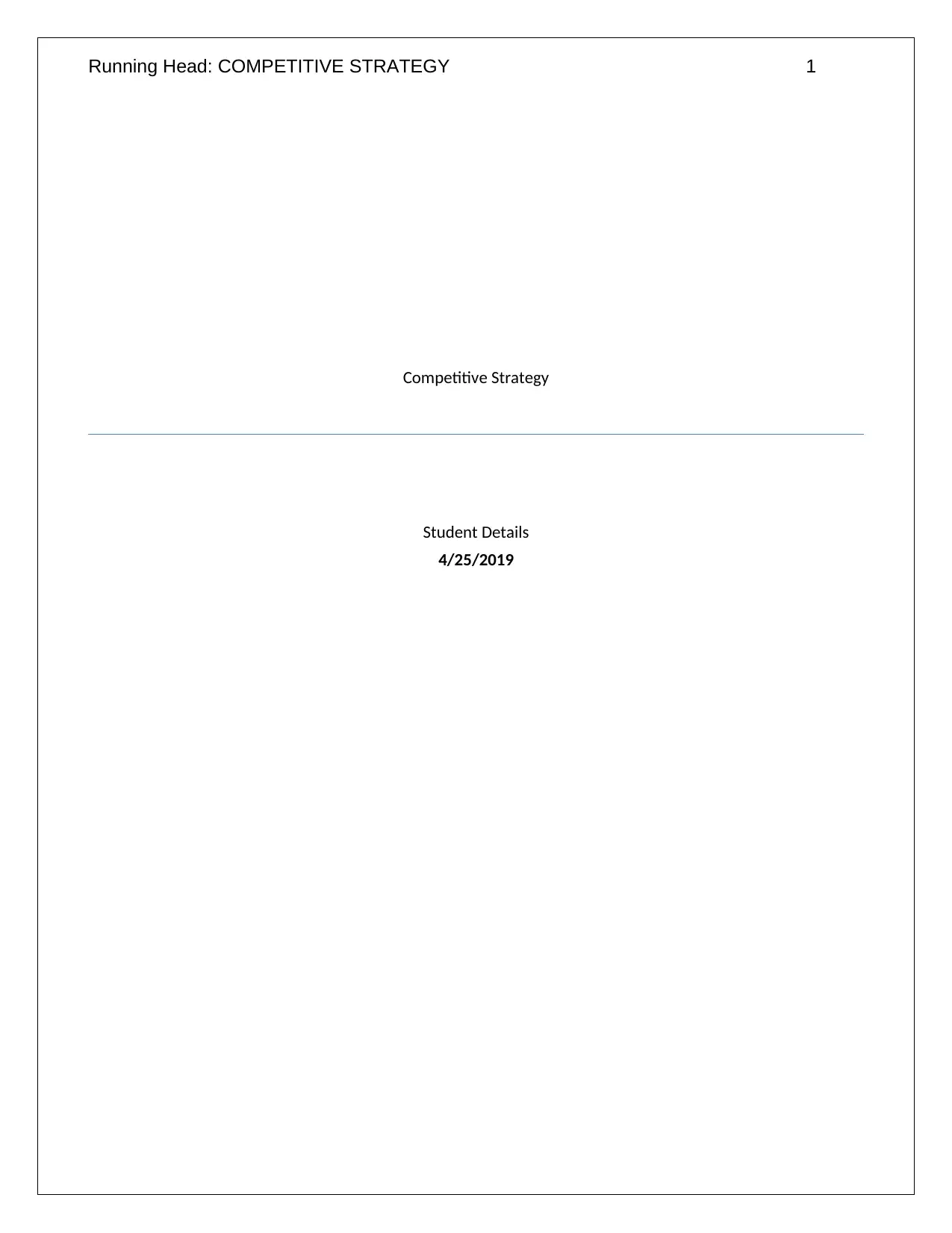
Running Head: COMPETITIVE STRATEGY 1
Competitive Strategy
Student Details
4/25/2019
Competitive Strategy
Student Details
4/25/2019
Paraphrase This Document
Need a fresh take? Get an instant paraphrase of this document with our AI Paraphraser
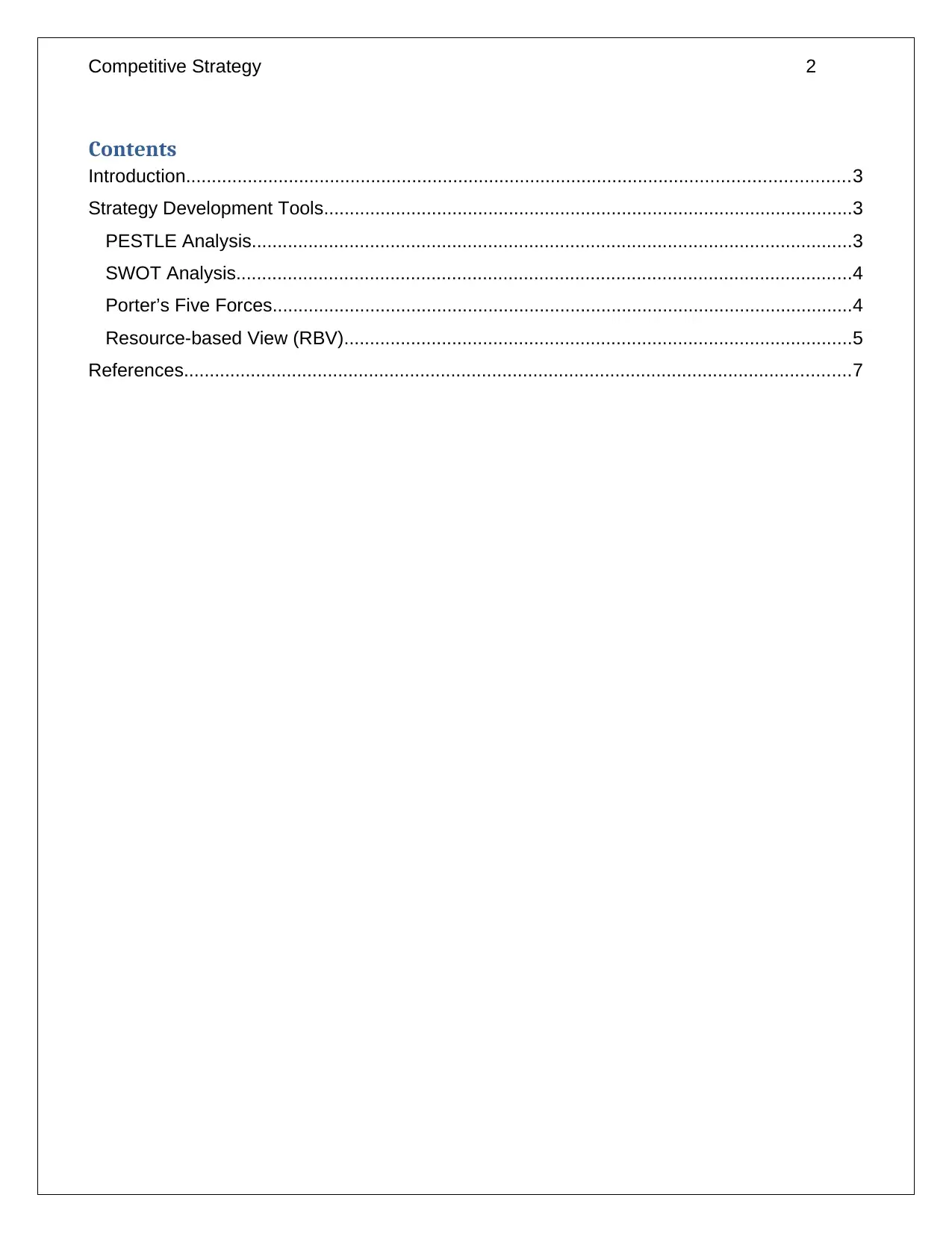
Competitive Strategy 2
Contents
Introduction.................................................................................................................................3
Strategy Development Tools.......................................................................................................3
PESTLE Analysis.....................................................................................................................3
SWOT Analysis........................................................................................................................4
Porter’s Five Forces.................................................................................................................4
Resource-based View (RBV)...................................................................................................5
References..................................................................................................................................7
Contents
Introduction.................................................................................................................................3
Strategy Development Tools.......................................................................................................3
PESTLE Analysis.....................................................................................................................3
SWOT Analysis........................................................................................................................4
Porter’s Five Forces.................................................................................................................4
Resource-based View (RBV)...................................................................................................5
References..................................................................................................................................7
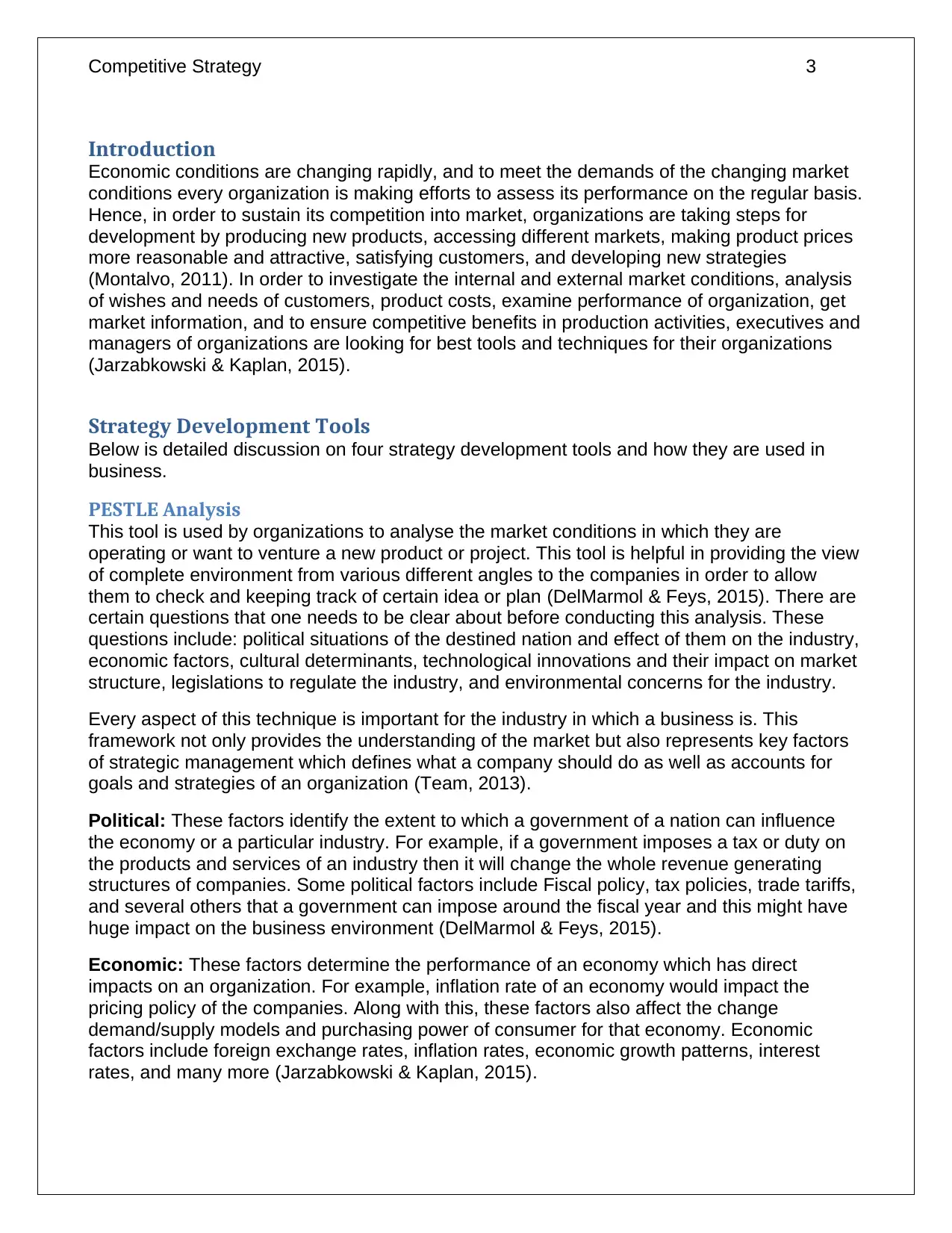
Competitive Strategy 3
Introduction
Economic conditions are changing rapidly, and to meet the demands of the changing market
conditions every organization is making efforts to assess its performance on the regular basis.
Hence, in order to sustain its competition into market, organizations are taking steps for
development by producing new products, accessing different markets, making product prices
more reasonable and attractive, satisfying customers, and developing new strategies
(Montalvo, 2011). In order to investigate the internal and external market conditions, analysis
of wishes and needs of customers, product costs, examine performance of organization, get
market information, and to ensure competitive benefits in production activities, executives and
managers of organizations are looking for best tools and techniques for their organizations
(Jarzabkowski & Kaplan, 2015).
Strategy Development Tools
Below is detailed discussion on four strategy development tools and how they are used in
business.
PESTLE Analysis
This tool is used by organizations to analyse the market conditions in which they are
operating or want to venture a new product or project. This tool is helpful in providing the view
of complete environment from various different angles to the companies in order to allow
them to check and keeping track of certain idea or plan (DelMarmol & Feys, 2015). There are
certain questions that one needs to be clear about before conducting this analysis. These
questions include: political situations of the destined nation and effect of them on the industry,
economic factors, cultural determinants, technological innovations and their impact on market
structure, legislations to regulate the industry, and environmental concerns for the industry.
Every aspect of this technique is important for the industry in which a business is. This
framework not only provides the understanding of the market but also represents key factors
of strategic management which defines what a company should do as well as accounts for
goals and strategies of an organization (Team, 2013).
Political: These factors identify the extent to which a government of a nation can influence
the economy or a particular industry. For example, if a government imposes a tax or duty on
the products and services of an industry then it will change the whole revenue generating
structures of companies. Some political factors include Fiscal policy, tax policies, trade tariffs,
and several others that a government can impose around the fiscal year and this might have
huge impact on the business environment (DelMarmol & Feys, 2015).
Economic: These factors determine the performance of an economy which has direct
impacts on an organization. For example, inflation rate of an economy would impact the
pricing policy of the companies. Along with this, these factors also affect the change
demand/supply models and purchasing power of consumer for that economy. Economic
factors include foreign exchange rates, inflation rates, economic growth patterns, interest
rates, and many more (Jarzabkowski & Kaplan, 2015).
Introduction
Economic conditions are changing rapidly, and to meet the demands of the changing market
conditions every organization is making efforts to assess its performance on the regular basis.
Hence, in order to sustain its competition into market, organizations are taking steps for
development by producing new products, accessing different markets, making product prices
more reasonable and attractive, satisfying customers, and developing new strategies
(Montalvo, 2011). In order to investigate the internal and external market conditions, analysis
of wishes and needs of customers, product costs, examine performance of organization, get
market information, and to ensure competitive benefits in production activities, executives and
managers of organizations are looking for best tools and techniques for their organizations
(Jarzabkowski & Kaplan, 2015).
Strategy Development Tools
Below is detailed discussion on four strategy development tools and how they are used in
business.
PESTLE Analysis
This tool is used by organizations to analyse the market conditions in which they are
operating or want to venture a new product or project. This tool is helpful in providing the view
of complete environment from various different angles to the companies in order to allow
them to check and keeping track of certain idea or plan (DelMarmol & Feys, 2015). There are
certain questions that one needs to be clear about before conducting this analysis. These
questions include: political situations of the destined nation and effect of them on the industry,
economic factors, cultural determinants, technological innovations and their impact on market
structure, legislations to regulate the industry, and environmental concerns for the industry.
Every aspect of this technique is important for the industry in which a business is. This
framework not only provides the understanding of the market but also represents key factors
of strategic management which defines what a company should do as well as accounts for
goals and strategies of an organization (Team, 2013).
Political: These factors identify the extent to which a government of a nation can influence
the economy or a particular industry. For example, if a government imposes a tax or duty on
the products and services of an industry then it will change the whole revenue generating
structures of companies. Some political factors include Fiscal policy, tax policies, trade tariffs,
and several others that a government can impose around the fiscal year and this might have
huge impact on the business environment (DelMarmol & Feys, 2015).
Economic: These factors determine the performance of an economy which has direct
impacts on an organization. For example, inflation rate of an economy would impact the
pricing policy of the companies. Along with this, these factors also affect the change
demand/supply models and purchasing power of consumer for that economy. Economic
factors include foreign exchange rates, inflation rates, economic growth patterns, interest
rates, and many more (Jarzabkowski & Kaplan, 2015).
⊘ This is a preview!⊘
Do you want full access?
Subscribe today to unlock all pages.

Trusted by 1+ million students worldwide
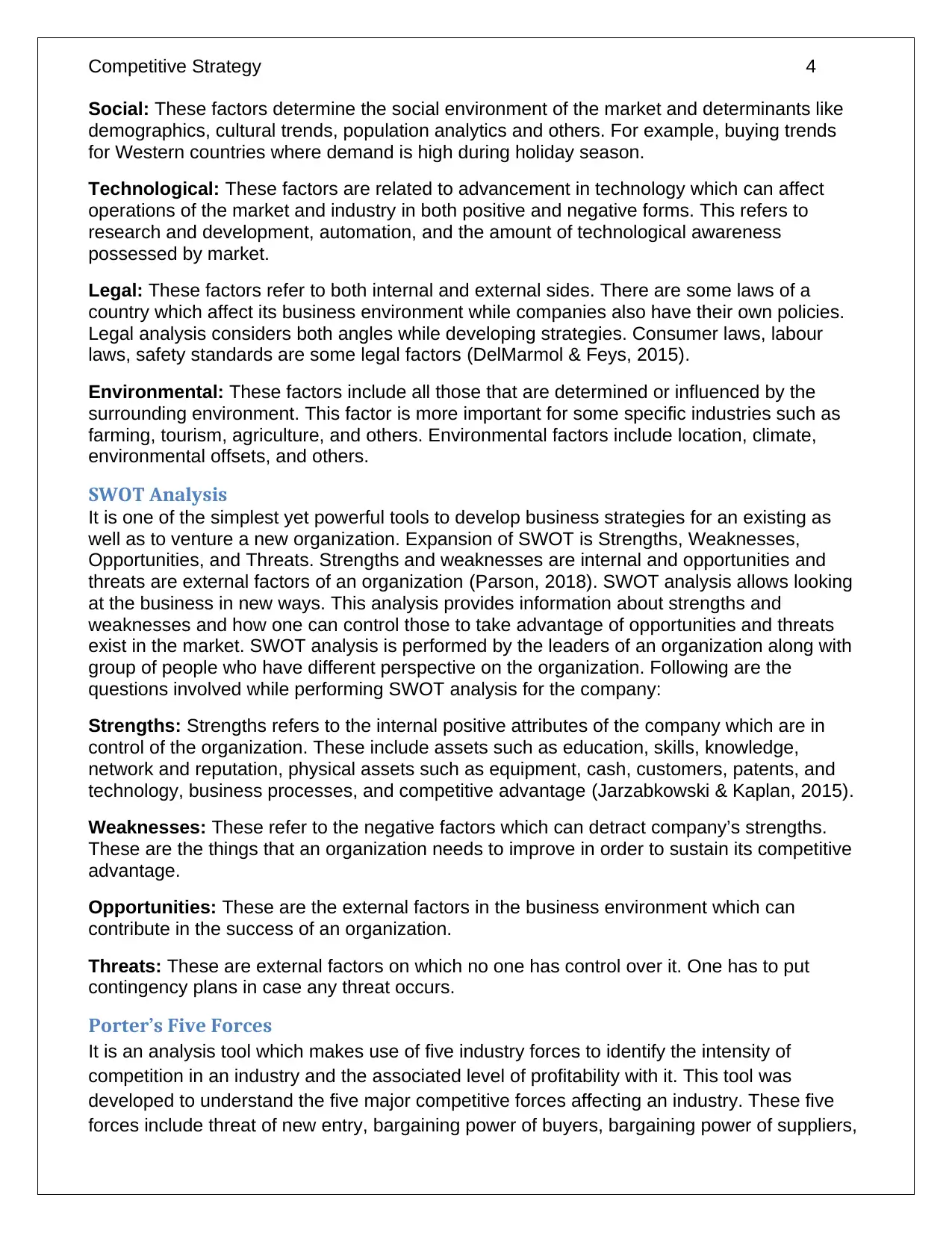
Competitive Strategy 4
Social: These factors determine the social environment of the market and determinants like
demographics, cultural trends, population analytics and others. For example, buying trends
for Western countries where demand is high during holiday season.
Technological: These factors are related to advancement in technology which can affect
operations of the market and industry in both positive and negative forms. This refers to
research and development, automation, and the amount of technological awareness
possessed by market.
Legal: These factors refer to both internal and external sides. There are some laws of a
country which affect its business environment while companies also have their own policies.
Legal analysis considers both angles while developing strategies. Consumer laws, labour
laws, safety standards are some legal factors (DelMarmol & Feys, 2015).
Environmental: These factors include all those that are determined or influenced by the
surrounding environment. This factor is more important for some specific industries such as
farming, tourism, agriculture, and others. Environmental factors include location, climate,
environmental offsets, and others.
SWOT Analysis
It is one of the simplest yet powerful tools to develop business strategies for an existing as
well as to venture a new organization. Expansion of SWOT is Strengths, Weaknesses,
Opportunities, and Threats. Strengths and weaknesses are internal and opportunities and
threats are external factors of an organization (Parson, 2018). SWOT analysis allows looking
at the business in new ways. This analysis provides information about strengths and
weaknesses and how one can control those to take advantage of opportunities and threats
exist in the market. SWOT analysis is performed by the leaders of an organization along with
group of people who have different perspective on the organization. Following are the
questions involved while performing SWOT analysis for the company:
Strengths: Strengths refers to the internal positive attributes of the company which are in
control of the organization. These include assets such as education, skills, knowledge,
network and reputation, physical assets such as equipment, cash, customers, patents, and
technology, business processes, and competitive advantage (Jarzabkowski & Kaplan, 2015).
Weaknesses: These refer to the negative factors which can detract company’s strengths.
These are the things that an organization needs to improve in order to sustain its competitive
advantage.
Opportunities: These are the external factors in the business environment which can
contribute in the success of an organization.
Threats: These are external factors on which no one has control over it. One has to put
contingency plans in case any threat occurs.
Porter’s Five Forces
It is an analysis tool which makes use of five industry forces to identify the intensity of
competition in an industry and the associated level of profitability with it. This tool was
developed to understand the five major competitive forces affecting an industry. These five
forces include threat of new entry, bargaining power of buyers, bargaining power of suppliers,
Social: These factors determine the social environment of the market and determinants like
demographics, cultural trends, population analytics and others. For example, buying trends
for Western countries where demand is high during holiday season.
Technological: These factors are related to advancement in technology which can affect
operations of the market and industry in both positive and negative forms. This refers to
research and development, automation, and the amount of technological awareness
possessed by market.
Legal: These factors refer to both internal and external sides. There are some laws of a
country which affect its business environment while companies also have their own policies.
Legal analysis considers both angles while developing strategies. Consumer laws, labour
laws, safety standards are some legal factors (DelMarmol & Feys, 2015).
Environmental: These factors include all those that are determined or influenced by the
surrounding environment. This factor is more important for some specific industries such as
farming, tourism, agriculture, and others. Environmental factors include location, climate,
environmental offsets, and others.
SWOT Analysis
It is one of the simplest yet powerful tools to develop business strategies for an existing as
well as to venture a new organization. Expansion of SWOT is Strengths, Weaknesses,
Opportunities, and Threats. Strengths and weaknesses are internal and opportunities and
threats are external factors of an organization (Parson, 2018). SWOT analysis allows looking
at the business in new ways. This analysis provides information about strengths and
weaknesses and how one can control those to take advantage of opportunities and threats
exist in the market. SWOT analysis is performed by the leaders of an organization along with
group of people who have different perspective on the organization. Following are the
questions involved while performing SWOT analysis for the company:
Strengths: Strengths refers to the internal positive attributes of the company which are in
control of the organization. These include assets such as education, skills, knowledge,
network and reputation, physical assets such as equipment, cash, customers, patents, and
technology, business processes, and competitive advantage (Jarzabkowski & Kaplan, 2015).
Weaknesses: These refer to the negative factors which can detract company’s strengths.
These are the things that an organization needs to improve in order to sustain its competitive
advantage.
Opportunities: These are the external factors in the business environment which can
contribute in the success of an organization.
Threats: These are external factors on which no one has control over it. One has to put
contingency plans in case any threat occurs.
Porter’s Five Forces
It is an analysis tool which makes use of five industry forces to identify the intensity of
competition in an industry and the associated level of profitability with it. This tool was
developed to understand the five major competitive forces affecting an industry. These five
forces include threat of new entry, bargaining power of buyers, bargaining power of suppliers,
Paraphrase This Document
Need a fresh take? Get an instant paraphrase of this document with our AI Paraphraser
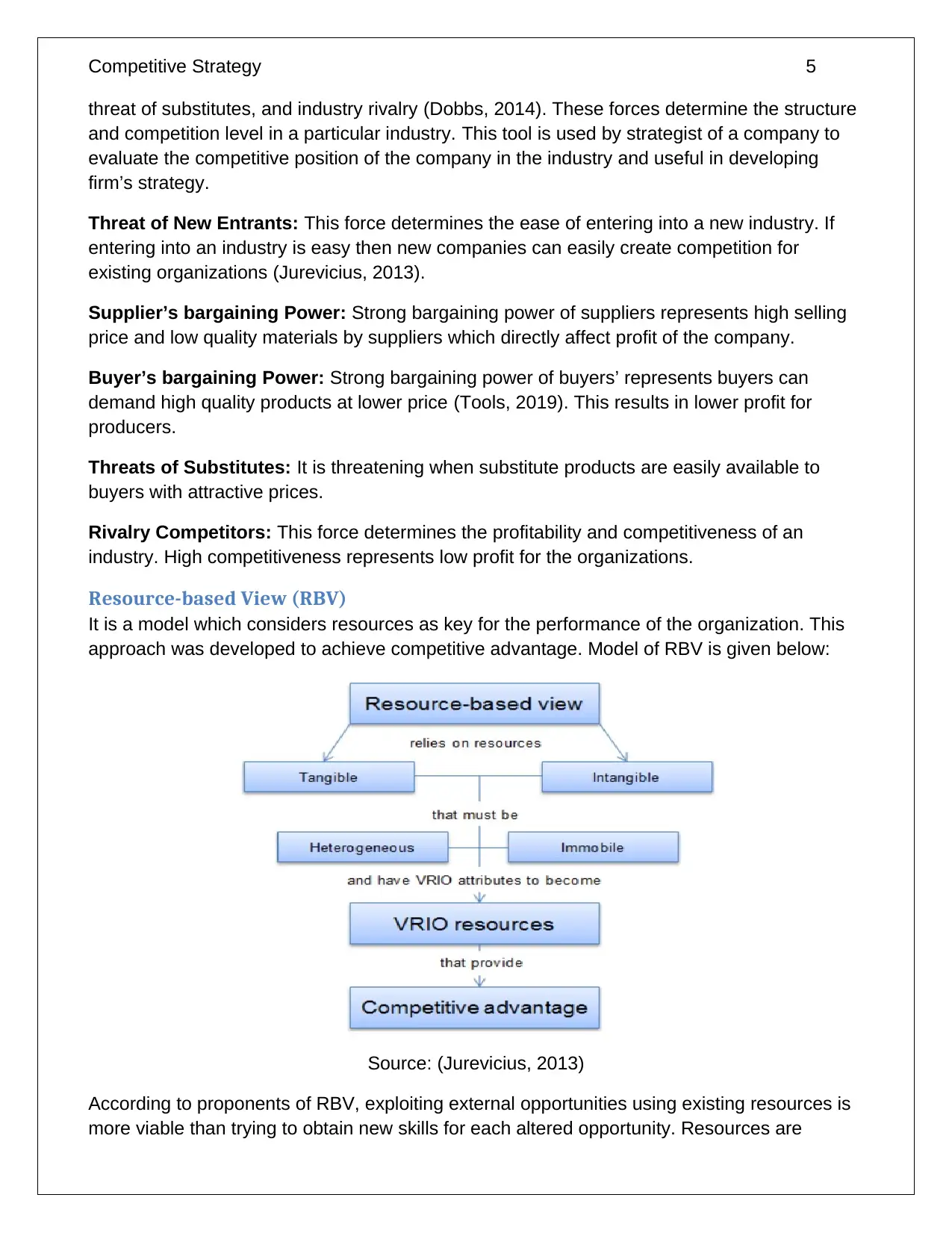
Competitive Strategy 5
threat of substitutes, and industry rivalry (Dobbs, 2014). These forces determine the structure
and competition level in a particular industry. This tool is used by strategist of a company to
evaluate the competitive position of the company in the industry and useful in developing
firm’s strategy.
Threat of New Entrants: This force determines the ease of entering into a new industry. If
entering into an industry is easy then new companies can easily create competition for
existing organizations (Jurevicius, 2013).
Supplier’s bargaining Power: Strong bargaining power of suppliers represents high selling
price and low quality materials by suppliers which directly affect profit of the company.
Buyer’s bargaining Power: Strong bargaining power of buyers’ represents buyers can
demand high quality products at lower price (Tools, 2019). This results in lower profit for
producers.
Threats of Substitutes: It is threatening when substitute products are easily available to
buyers with attractive prices.
Rivalry Competitors: This force determines the profitability and competitiveness of an
industry. High competitiveness represents low profit for the organizations.
Resource-based View (RBV)
It is a model which considers resources as key for the performance of the organization. This
approach was developed to achieve competitive advantage. Model of RBV is given below:
Source: (Jurevicius, 2013)
According to proponents of RBV, exploiting external opportunities using existing resources is
more viable than trying to obtain new skills for each altered opportunity. Resources are
threat of substitutes, and industry rivalry (Dobbs, 2014). These forces determine the structure
and competition level in a particular industry. This tool is used by strategist of a company to
evaluate the competitive position of the company in the industry and useful in developing
firm’s strategy.
Threat of New Entrants: This force determines the ease of entering into a new industry. If
entering into an industry is easy then new companies can easily create competition for
existing organizations (Jurevicius, 2013).
Supplier’s bargaining Power: Strong bargaining power of suppliers represents high selling
price and low quality materials by suppliers which directly affect profit of the company.
Buyer’s bargaining Power: Strong bargaining power of buyers’ represents buyers can
demand high quality products at lower price (Tools, 2019). This results in lower profit for
producers.
Threats of Substitutes: It is threatening when substitute products are easily available to
buyers with attractive prices.
Rivalry Competitors: This force determines the profitability and competitiveness of an
industry. High competitiveness represents low profit for the organizations.
Resource-based View (RBV)
It is a model which considers resources as key for the performance of the organization. This
approach was developed to achieve competitive advantage. Model of RBV is given below:
Source: (Jurevicius, 2013)
According to proponents of RBV, exploiting external opportunities using existing resources is
more viable than trying to obtain new skills for each altered opportunity. Resources are
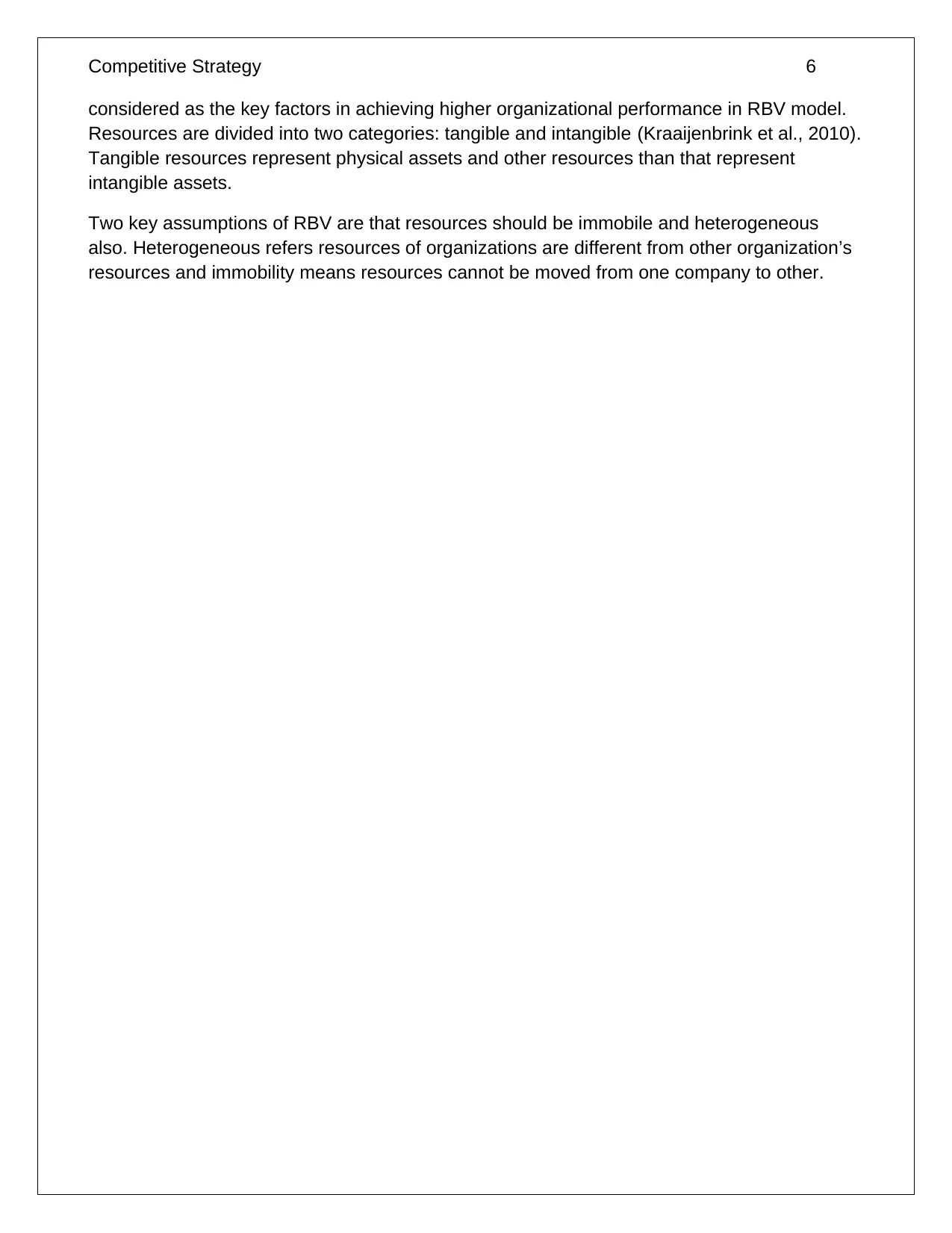
Competitive Strategy 6
considered as the key factors in achieving higher organizational performance in RBV model.
Resources are divided into two categories: tangible and intangible (Kraaijenbrink et al., 2010).
Tangible resources represent physical assets and other resources than that represent
intangible assets.
Two key assumptions of RBV are that resources should be immobile and heterogeneous
also. Heterogeneous refers resources of organizations are different from other organization’s
resources and immobility means resources cannot be moved from one company to other.
considered as the key factors in achieving higher organizational performance in RBV model.
Resources are divided into two categories: tangible and intangible (Kraaijenbrink et al., 2010).
Tangible resources represent physical assets and other resources than that represent
intangible assets.
Two key assumptions of RBV are that resources should be immobile and heterogeneous
also. Heterogeneous refers resources of organizations are different from other organization’s
resources and immobility means resources cannot be moved from one company to other.
⊘ This is a preview!⊘
Do you want full access?
Subscribe today to unlock all pages.

Trusted by 1+ million students worldwide
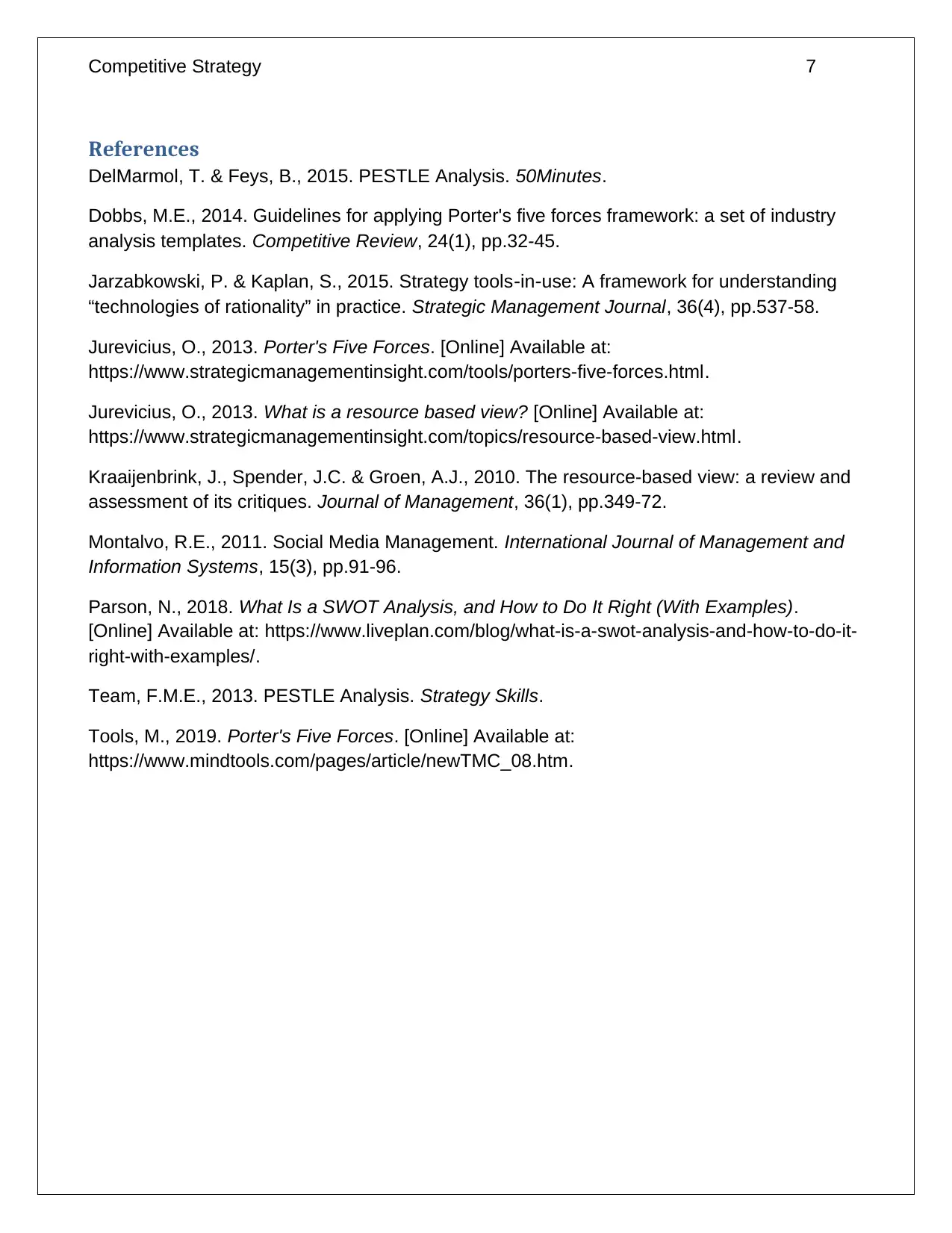
Competitive Strategy 7
References
DelMarmol, T. & Feys, B., 2015. PESTLE Analysis. 50Minutes.
Dobbs, M.E., 2014. Guidelines for applying Porter's five forces framework: a set of industry
analysis templates. Competitive Review, 24(1), pp.32-45.
Jarzabkowski, P. & Kaplan, S., 2015. Strategy tools‐in‐use: A framework for understanding
“technologies of rationality” in practice. Strategic Management Journal, 36(4), pp.537-58.
Jurevicius, O., 2013. Porter's Five Forces. [Online] Available at:
https://www.strategicmanagementinsight.com/tools/porters-five-forces.html.
Jurevicius, O., 2013. What is a resource based view? [Online] Available at:
https://www.strategicmanagementinsight.com/topics/resource-based-view.html.
Kraaijenbrink, J., Spender, J.C. & Groen, A.J., 2010. The resource-based view: a review and
assessment of its critiques. Journal of Management, 36(1), pp.349-72.
Montalvo, R.E., 2011. Social Media Management. International Journal of Management and
Information Systems, 15(3), pp.91-96.
Parson, N., 2018. What Is a SWOT Analysis, and How to Do It Right (With Examples).
[Online] Available at: https://www.liveplan.com/blog/what-is-a-swot-analysis-and-how-to-do-it-
right-with-examples/.
Team, F.M.E., 2013. PESTLE Analysis. Strategy Skills.
Tools, M., 2019. Porter's Five Forces. [Online] Available at:
https://www.mindtools.com/pages/article/newTMC_08.htm.
References
DelMarmol, T. & Feys, B., 2015. PESTLE Analysis. 50Minutes.
Dobbs, M.E., 2014. Guidelines for applying Porter's five forces framework: a set of industry
analysis templates. Competitive Review, 24(1), pp.32-45.
Jarzabkowski, P. & Kaplan, S., 2015. Strategy tools‐in‐use: A framework for understanding
“technologies of rationality” in practice. Strategic Management Journal, 36(4), pp.537-58.
Jurevicius, O., 2013. Porter's Five Forces. [Online] Available at:
https://www.strategicmanagementinsight.com/tools/porters-five-forces.html.
Jurevicius, O., 2013. What is a resource based view? [Online] Available at:
https://www.strategicmanagementinsight.com/topics/resource-based-view.html.
Kraaijenbrink, J., Spender, J.C. & Groen, A.J., 2010. The resource-based view: a review and
assessment of its critiques. Journal of Management, 36(1), pp.349-72.
Montalvo, R.E., 2011. Social Media Management. International Journal of Management and
Information Systems, 15(3), pp.91-96.
Parson, N., 2018. What Is a SWOT Analysis, and How to Do It Right (With Examples).
[Online] Available at: https://www.liveplan.com/blog/what-is-a-swot-analysis-and-how-to-do-it-
right-with-examples/.
Team, F.M.E., 2013. PESTLE Analysis. Strategy Skills.
Tools, M., 2019. Porter's Five Forces. [Online] Available at:
https://www.mindtools.com/pages/article/newTMC_08.htm.
1 out of 7
Related Documents
Your All-in-One AI-Powered Toolkit for Academic Success.
+13062052269
info@desklib.com
Available 24*7 on WhatsApp / Email
![[object Object]](/_next/static/media/star-bottom.7253800d.svg)
Unlock your academic potential
Copyright © 2020–2025 A2Z Services. All Rights Reserved. Developed and managed by ZUCOL.





